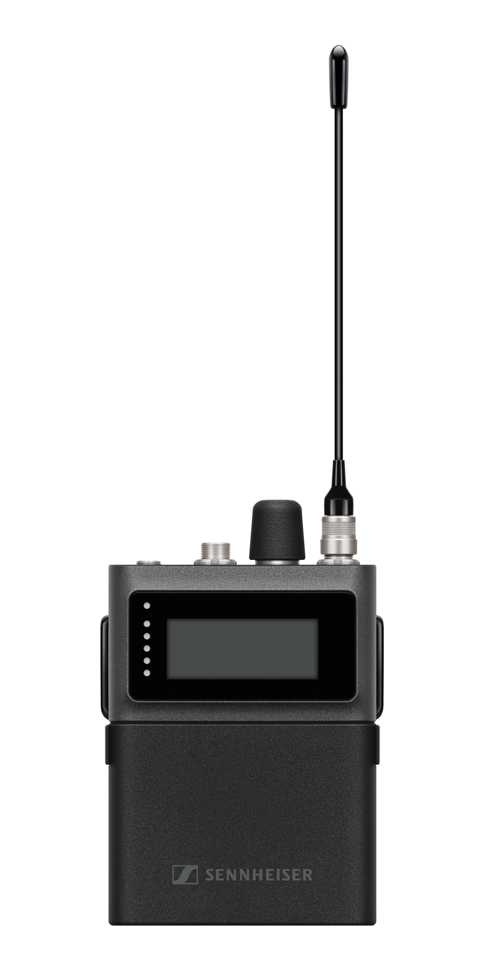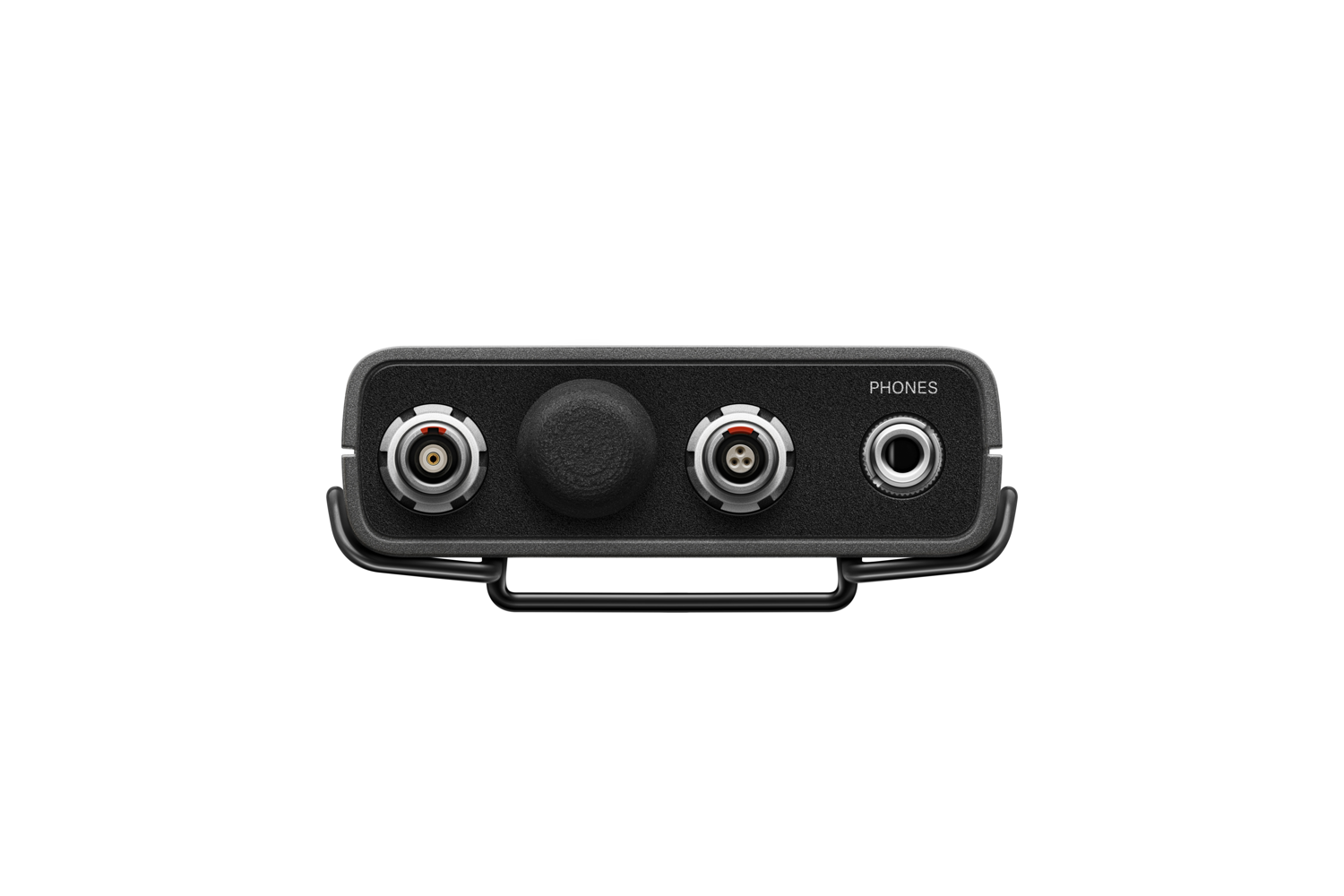Sennheiser Spectera

Unveiling the world’s first wideband, bidirectional, digital wireless ecosystem
Amsterdam, NL, September 13, 2024– At IBC, Sennheiser ushers in a new era of digital wireless audio transmission with the world’s first bidirectional wideband solution: Spectera. Using the ground-breaking WMAS (Wireless Multichannel Audio Systems) technology, Spectera greatly reduces wireless system complexity, while at the same time considerably increasing capability, enabling time-saving workflows and offering full remote control and monitoring, including permanent spectrum sensing. Spectera features bidirectional bodypacks that manage both digital IEM/IFB and mic/line signals at the same time. The solution is remarkably resistant to RF fading and allows for flexible use of the wideband RF channel, for example for digital IEMs with a latency down to a spectacular 0.7 milliseconds.

“We are thrilled to see years of technological development and spectrum policy work turn into a digital wireless ecosystem that will solve many of the issues that users of wireless multichannel systems are faced with today,” say co-CEOs Dr Andreas Sennheiser and Daniel Sennheiser. “Our wideband solution will be ideal for large productions, whether in the touring, broadcasting, or theatre fields, or in any other area that requires multichannel audio setups. Spectera satisfies our customers’ chief desires and needs regarding ease of use, operational reliability and flexibility. It offers less hardware, drastically reduced frequency coordination, redundancy, and the flexibility of an ecosystem that grows with your needs.”
Powered by WMAS – The wideband approach
Bidirectional digital wideband transmission addresses many of the typical challenges that users, operators and owners of wireless audio systems experience today. These challenges include overly complex frequency coordination and complicated rack cabling for high channel counts, and the large footprint that a multichannel wireless system still has – in the warehouse, on tour and backstage, both for space and the amount of time required for load-in, load-out and setup.
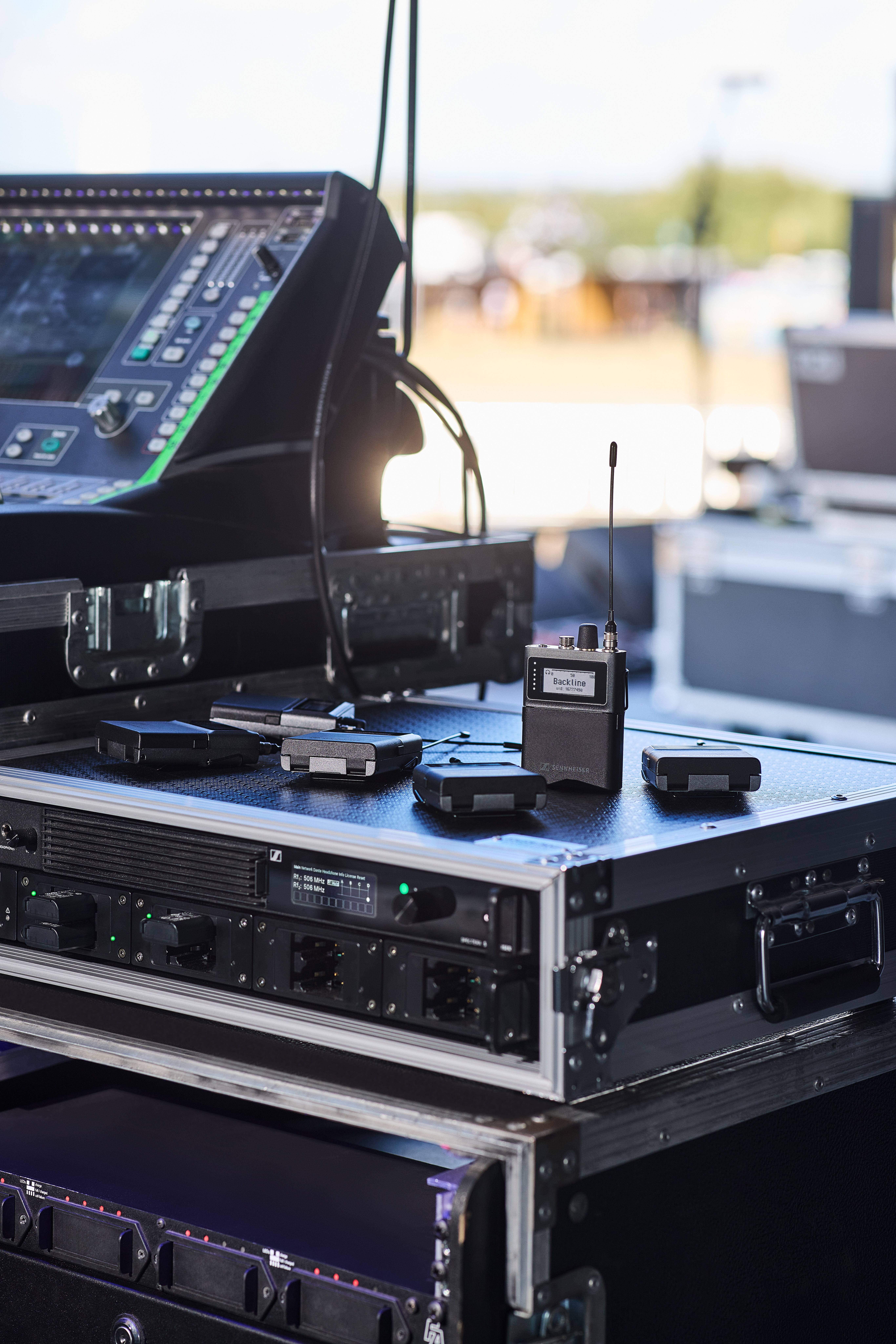
Sebastian Georgi and Jan Watermann are the inventors of the specific Sennheiser approach to WMAS. The technology they developed is a proprietary variant of OFDM-TDMA, specifically tailored to reliable multichannel, bidirectional, low-latency communication. They succinctly compare this wideband approach to standard narrowband technology: “Instead of many individual 200 kHz narrowband RF carrier frequencies, we use a single wideband RF channel for audio transmission – bidirectional transmission of audio and control data, to be more exact. In Sennheiser’s approach, the wideband RF channel is a TV channel of 6 or 8 MHz, depending on local regulations. The WMAS system organises its audio links within this channel. Every audio link, be it a mic or an IEM, is assigned specific time slots for transmitting its audio information – for the first time, it is possible to have IEMs and mics in the very same TV channel instead of two channels separated by a guard band. Thanks to the fact that all audio links use the full width of the RF channel when it’s ‘their turn’, RF fading is greatly reduced. It corresponds to 40-fold diversity for an 8 MHz RF channel and 30-fold diversity for a 6 MHz TV channel. Also, the spectral density is low, which makes it easier to reuse frequencies, for example on a larger festival ground, between neighbouring theatres, or in a broadcasting complex.”
Greatly reduced system complexity
One of the most stunning innovations in the Spectera ecosystem is certainly the Base Station, which, in a single rack unit with 32 inputs and 32 outputs, replaces a rack-full of wireless mic receivers and IEM transmitters. An entire production could be accommodated in a single wideband RF channel (6 or 8 MHz). The lower footprint continues to the bodypacks, which handle mic/line and IEM/IFB requirements simultaneously. “Having just one pack is not only a great asset for performers,” says Bernd Neubauer, Spectera product management, “it also makes the work of the sound engineer easier, who has just one type of pack and can, if required, quickly add an IEM to a mic. Warehousing also becomes less complex, with just one Base Station and two frequency variants – UHF and 1G4 – for bodypacks and antennas.”
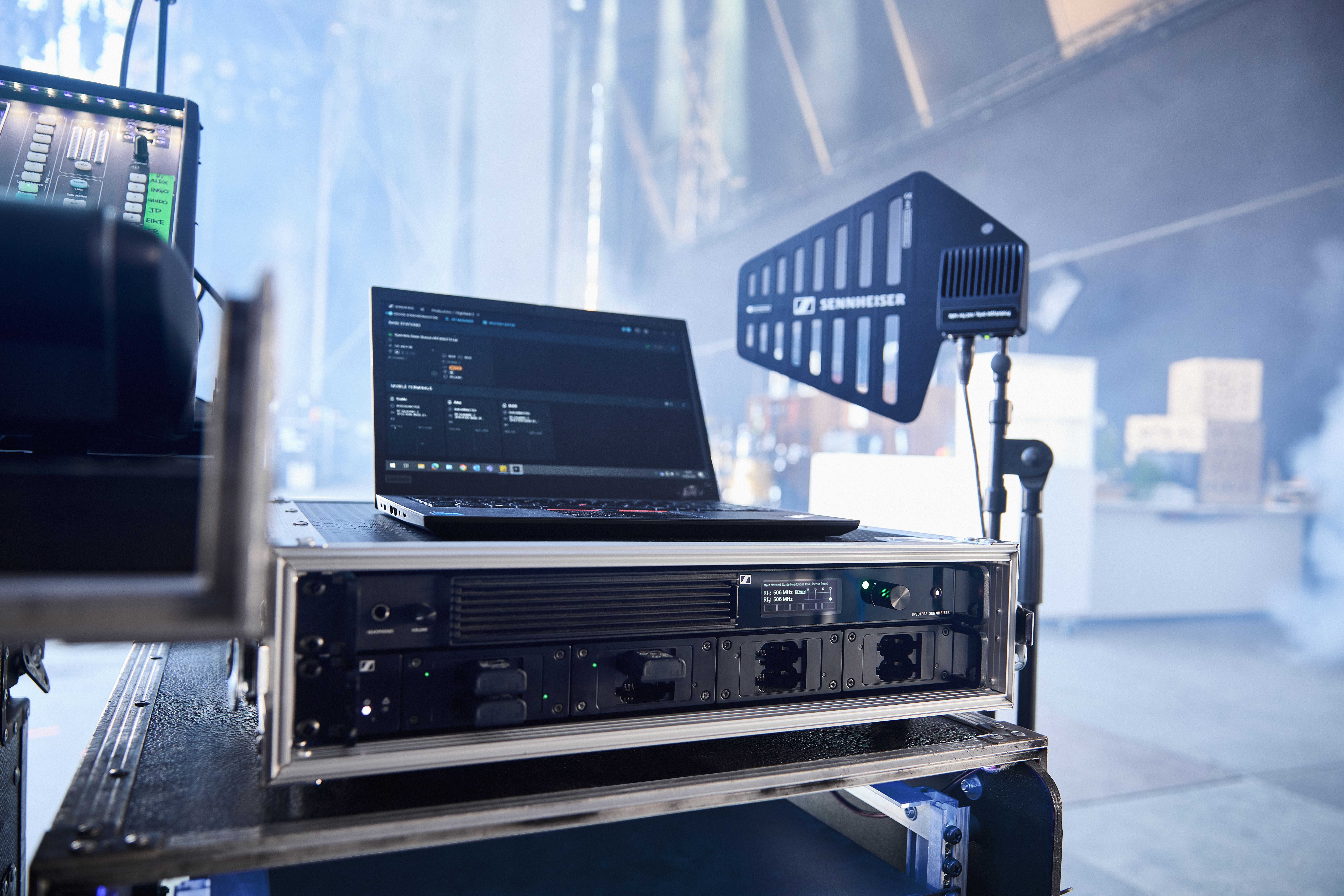
The future of wireless pro audio is here – and it’s bidirectional
Spectera represents a total shift in control and monitoring: It doesn’t just offer a back channel, but continuous two-way communication throughout, for truly complete remote control. Via the permanent control data stream, audio settings can be adjusted, IEM and mic levels adapted, RF health and battery status monitored, and much more. AES 256 encryption (AES 256 CTR Mode with >10kYears expiry) for both audio and control data ensures the necessary data privacy.
Also, all units help in continuously sensing the spectrum, meaning they scan for potential interference from other RF sources. With Spectera, it is possible for the first time to see “behind” the RF channel that is actually being used and detect interference.
Excellent audio quality
Spectera delivers signature Sennheiser digital audio quality for mics, instruments and IEMs, employing different application-optimised audio codecs, which are all internally processed with 32-bit-float precision.
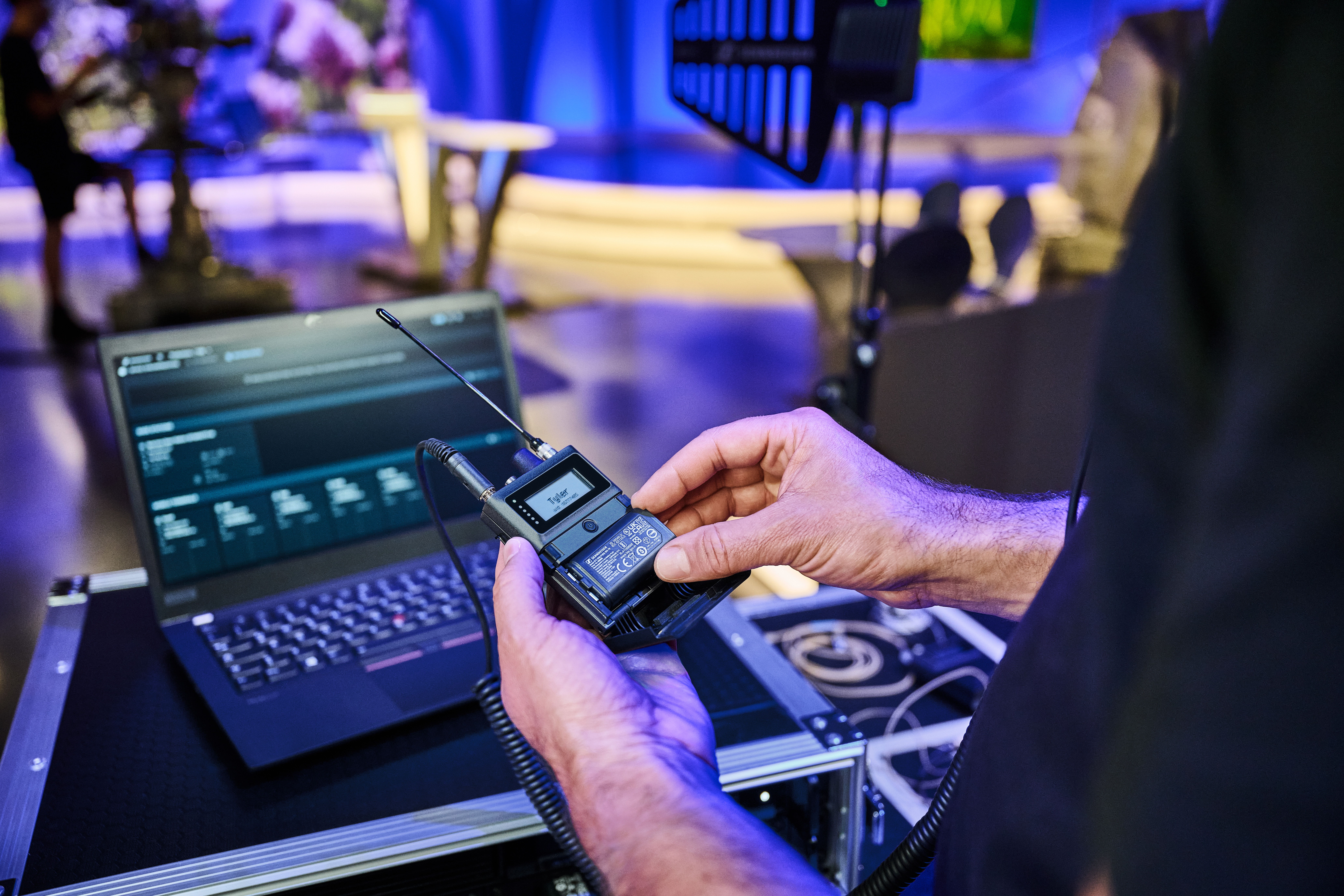
Various Audio Link Modes allow for selectable control of audio quality, latency, channel count, and operating range for each and every audio link, flexibly throughout a production. The operator can always use the RF channel to the maximum, either by giving fewer audio links a high quality or by allowing more links and reducing the quality accordingly. No matter which Audio Link Mode gets selected, Spectera offers incredibly clear sound, which “will be a revelation for IEM users especially”, says Neubauer. “With Spectera, you get stunning digital IEM clarity and accuracy with ultra-low latency down to 0.7 milliseconds. Dual Mono transmission ensures a clean separation of the in-ear channels, enhancing the sound stage for optimal performance.”
Benedikt Euen, Spectera product management, adds, “Spectera is very respectful of spectrum resources by enabling IEMs and mics to be in the very same TV channel. It also simplifies frequency coordination among engineers at festivals, and enables faster workflows. For example, if a large band is waiting for their gig at a festival, it will only take a simple unmuting of their RF to get the entire band ‘on air’. Where narrowband systems tie you to a fixed set of frequencies and features, Spectera allows you to handle your show or production totally flexibly. An additional IEM is needed? No problem! You need to fit another artist within your 64 audio links? Can be accommodated!”
A closer look at the Spectera components
The Base Station – 1 U, up to 64 wireless audio links
The rack-mount Base Station is the heart of the Spectera ecosystem, and is a true space-saver. It handles up to 64 audio links, meaning 32 inputs and 32 outputs, in a mere 19”, 1U format. One Base Station accommodates up to two RF wideband channels. The Base Station is frequency-agnostic; activation of the respective local license for the Base Station will automatically load the authorised frequency ranges.
The Spectera Base Station (front and back)
Redundancy has been key in the design of the Base Station. It features two PSUs, primary and secondary Dante connections, two slots for optional redundant MADI connections (optical or BNC) and four antenna ports, which not only allow for redundancy, but also for extended, synchronised antenna zone coverage or higher system capacity by using additional frequency ranges. The cascade ports on the unit will be activated with a future firmware release. Worth noting: There are no RF components in the Base Station, so there is no interference with other wireless equipment in the rack.
The SEK Bodypack does it all – mic and IEM
The SEKs, too, are space-savers because the very same bodypack can handle both IEM and microphone or instrument requirements, and this can be flexibly determined and changed during a show.
The Spectera SEK bodypack can be a mic/instrument transmitter and IEM receiver at the same time
The bodypack features a 3-pin connector for a lavalier or headset microphone (select from a wide range of acclaimed Sennheiser models) or instrument cable. The 3.5 mm headphone jack connects to Sennheiser’s range of professional in-ear phones and features an impedance-matching high-power headphone amplifier. The SEK is fitted with a persistent display, where device information is retained on the display even when a unit has been powered down.
The bodypack is available in a UHF (470 – 608 MHz and 630 – 698 MHz) and a 1G4 (1350 – 1400 MHz and 1435 – 1525 MHz) frequency variant. It is powered by a BA 70 rechargeable battery (the same as for as Evolution Wireless Digital) and can deliver up to seven hours of operating time depending on the selected configuration.
The DAD Antenna – an antenna quite unlike any other
The IP 54 protected DAD antenna is a transceiving antenna that manages mic/line signals, IEM signals, and control data at the same time. The antenna carries the RF components of the system, eliminating the need for boosters, splitters and combiners. The RF is digitized here, therefore the DAD antenna does not use a BNC connector and co-axial cable for connection to the Base Station, but a ruggedized RJ 45 connector and CAT 5e cable instead, which are much easier to handle, more cost-effective, and not prone to cable losses like co-axial cables. The antenna is powered by the Base Station via PoE.

Sennheiser offers high-quality CAT 5e cables with lengths of 10 m, 25 m, and 50 m. It is also possible to use Layer 1 media conversion to fibre to cover larger venues.
LinkDesk Software
If the Base Station is the heart of the Spectera ecosystem, the all-new LinkDesk software is its backbone. The desktop application runs on Mac or PC and turns it into a remote control and monitoring centre.

Here, the operator can flexibly choose between the Audio Link Modes with their varying levels of audio quality, latency, possible audio links and range, as well as fully remote control, and monitor the entire system, with visibility of all audio settings and RF statuses.
Euen explains, “Setting up a multichannel wireless system can be a true challenge on the software side, too. Therefore, we introduced assistive behaviours to make system management as fast and intuitive as possible. LinkDesk also stores productions, so operators can quickly recall their system configurations and save time at the event.” Smart notifications offer additional assistance.
The LinkDesk software also handles the activation of the Base Station via single node-based licenses. By entering the specific local license code, the software ensures that the system operates within the local regulatory requirements for frequencies, RF channel bandwidth, and transmission power, putting operators on the safe side regarding compliance.
Availability and advancing the ecosystem
Spectera can be pre-ordered from today. The date when shipping commences will be announced during the first half of 2025. All through 2025, a special introductory pricing will be in place.
Spectera will evolve over time with continuous hardware, software, feature and service enhancements. On the hardware side, the next addition will be the SKM handheld transmitter. Regarding features, the implementation of the SMPTE ST 2110 family of standards for the transmission of professional media signals is planned which, in the meantime, can be achieved with Merging Technologies’ Hapi.

“The Spectera ecosystem is a tool for the industry that will help combat the issues that have made the use of wireless so complicated until now,” says Neubauer. “We will be collaborating closely with the industry on the new technology, and get valued customer input on system performance, usage scenarios and future updates.”
New applications on the horizon
“Spectera will not only revolutionise multichannel wireless audio, but also open up many new opportunities,” says Andreas Sennheiser. “3D immersive audio is one such opportunity. Thanks to its synchronised word clock for all audio over RF, Spectera will be the first solution that is able to capture phase-coherent wireless audio for immersive recording and reproduction.”
“With the new workflows that this ecosystem facilitates, we will certainly see new creative uses of wireless audio technology,” concludes Daniel Sennheiser.
(Ends)
The images accompanying this media release as well as additional product and application pictures can be downloaded here.



